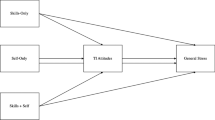Abstract
The majority of individuals working with justice-involved youth receive limited training addressing the impact of childhood trauma. There is a need for trauma-related training for staff, as well as valid measures to evaluate the effectiveness of training. The National Child Traumatic Stress Network designed a training curriculum, Think Trauma, which educates staff about the impact of trauma on justice-involved youth. A 45-item Think Trauma Evaluation Questionnaire (TTEQ) was developed to assess participants’ changes in knowledge and attitudes. This article examines the factor structure and internal consistency of this questionnaire. Two-hundred and ninety-six employees at two secure juvenile detention centers completed the TTEQ. The results suggest that the questionnaire is feasible to administer to a large group and has a factor structure corresponding to areas covered in the curriculum. A reliable and valid measure of trauma knowledge and attitudes is important to identifying the training needs for a particular facility.
Similar content being viewed by others
References
Abram, K. M., Teplin, L. A., Charles, D. R., Longworth, S. L., McClelland, G. M., & Dulcan, M. K. (2004). Posttraumatic stress disorder and trauma in youth in juvenile detention. Archives of General Psychiatry, 61(4), 403–410.
Costello, A. B., & Osborne, J. W. (2005). Best practices in exploratory factor analysis: four recommendations for getting the most from your analysis. Practical Assessment, Research and Evaluation, 10(7), 1–9. Available online: http://pareonline.net/getvn.asp?v=10andn=7.
Dierkhising, C.B., Ko, S.J., Woods-Jaeger, B., Briggs, E.C., Lee, R., & Pynoos, R.S. (2013). Trauma histories among justice-involved youth: findings from the National Child Traumatic Stress Network. European Journal of Psychotraumatology, 4, 10.3402/ejpt.v4i0.20274.
Doak, L. G., & Doak, C. C. (1980). Patient comprehension profiles: recent findings and strategies. Patient Counseling and Health Education, 2(3), 101–106.
Doak, C. C., Doak, L. G., & Root, J. (1996). Teaching patients with low literacy skills (2nd ed.). Philadelphia: Lippincott.
Felitti, V. J., Anda, R. F., Nordenberg, D., Williamson, D. F., Spitz, A. M., Edwards, V., Koss, M. P., & Marks, S. (1998). Relationship of childhood abuse and household dysfunction to many of the leading causes of death in adults: The Adverse Childhood Experiences (ACE) Study. American Journal of Preventive Medicine, 14(4), 245–258.
Ford, J. D., Chapman, J., Mack, M., & Pearson, G. (2006). Pathways from traumatic child maltreatment to delinquency: implications for juvenile and permanency court proceedings and decisions. Juvenile and Family Court Journal, 57(1), 13–26.
Ford, J. D., Chapman, J. C., Connor, D. F., & Cruise, K. C. (2012). Complex trauma and aggression in secure juvenile justice settings. Criminal Justice and Behavior, 39, 694–724.
Gould, M., Greenberg, N., & Hetherton, J. (2007). Stigma and the military: evaluation of a PTSD psychoeducational program. Journal of Traumatic Stress, 20(4), 505–515.
Marrow, M., Benamati, J., Decker, K., Griffin, D., & Lott, D. A. (2012). Think trauma: A training for staff in juvenile justice residential settings. Los Angeles: National Center for Child Traumatic Stress.
Mckenzie, K. J., & Smith, D. I. (2006). Posttraumatic stress disorder: examination of what clinicians know. Clinical Psychologist, 10(2), 78–85.
Munro, C. G., Freeman, C. P., & Law, R. (2004). General practitioners’ knowledge of post-traumatic stress disorder: a controlled study. The British Journal of General Practice, 54(508), 843–847.
Pynoos, R. S., Steinberg, A. M., & Goenjian, A. (1996). Traumatic stress in childhood and adolescence: Recent developments and current controversies. In B. A. van der Kolk & A. C. McFarlane (Eds.), Traumatic stress: The effects of overwhelming experience on mind, body, and society (pp. 331–358). New York: Guilford Press.
Richardson, L., Marrow, M., Benamati, J., Decker, K., Griffin, D., & Lott, D. A. (2013). Think Trauma Evaluation Questionnaire. Think trauma: A training for staff in juvenile justice residential settings. Los Angeles: National Center for Child Traumatic Stress.
Ruzek, J. I., Rosen, R. C., Marceau, L., Larson, M. J., Garvert, D. W., Smith, L., & Stoddard, A. (2012). Online self-administered training for post-traumatic stress disorder treatment providers: design and methods for a randomized, prospective intervention study. Implementation Science, 7(1), 43–57.
Samuelson, K. W., Koenig, C. J., McCamish, N., Choucroun, G., Tarasovsky, G., Bertenthal, D., & Seal, K. H. (2014). Web-based PTSD training for primary care providers: a pilot study. Psychological Services, 11(2), 153–161.
Steiner, H., Garcia, I. G., & Matthews, Z. (1997). Posttraumatic stress disorder in incarcerated juvenile delinquents. Journal of the American Academy of Child and Adolescent Psychiatry, 36(3), 357–365.
Wasserman, G. A., McReynolds, L. S., Ko, S. J., Katz, L. M., Cauffman, E., Haxton, W., & Lucas, C. P. (2004). Screening for emergent risk and service needs among incarcerated youth: comparing MAYSI-2 and voice DISC-IV. Journal of the American Academy of Child and Adolescent Psychiatry, 43(5), 629–639.
Weine, S. M., Kuc, G., Dzudza, E., Razzano, L., & Pavkovic, I. (2001). PTSD among Bosnian refugees: a survey of providers’ knowledge, attitudes and service patterns. Community Mental Health Journal, 37(3), 261–271.
Wood, J., Foy, D. W., Goguen, C. A., Pynoos, R., & James, C. B. (2002). Violence exposure and PTSD among delinquent girls. Journal of Aggression, Maltreatment & Trauma, 6(1), 109–126.
Ziegler, M. F., Greenwald, M. H., DeGuzman, M. A., & Simon, H. K. (2005). Posttraumatic stress responses in children: awareness and practice among a sample of pediatric emergency care providers. Pediatrics, 115(5), 1261–1267.
Acknowledgments
This study was supported by a grant from the Substance Abuse and Mental Health Services Administration (SM061202-01) to Bellevue Hospital Center.
Author information
Authors and Affiliations
Corresponding author
Rights and permissions
About this article
Cite this article
Marr, M., Surko, M., Storfer-Isser, A. et al. Think Trauma Evaluation Questionnaire: Factor Structure and Feasibility of Large Scale Administration. Journ Child Adol Trauma 8, 229–235 (2015). https://doi.org/10.1007/s40653-015-0064-x
Published:
Issue Date:
DOI: https://doi.org/10.1007/s40653-015-0064-x




